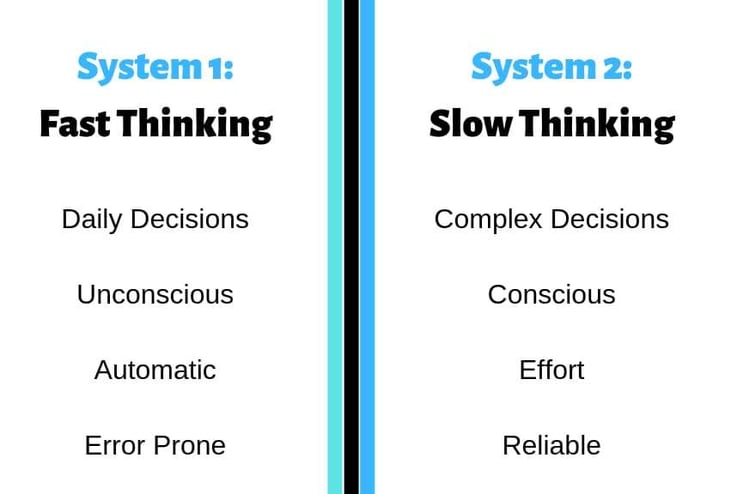What is System 1 and System 2?
System 1 and System 2 are the two decision making processes researched by Professor Daniel Kahneman’s book Thinking Fast & Slow.
• System 1 is the brain’s automatic, intuitive, and unconscious thinking mode. It requires little energy or attention, but it is often biased prone. System 1 is more influential and guides our day-to-day decisions.
• System 2 is a slow, controlled, and analytical method of thinking where reason dominates. Unlike system 1, it requires energy and attention to think through all the choices. It will filter out the automatic instincts and biases to make the best choice. In essence, system 2 should monitor our system 1 thoughts. However, system 2 thinking can produce poor results or irrational results.

System 1: Where We Spend Our Time vs. System 2: The Hard Decisions
As humans, we consider ourselves to be rational creatures – and, therefore, assume we spend most of our time in system 2. However, we spend almost all our time in system 1.
System 1 continuously creates impressions, intuitions, and judgments based on our daily routines. When faced with a decision, we automatically go with our system 1 thought. System 2 thinking occurs when faced with a new situation (or if we make a conscious effort). Our brains simply choose the easiest path rather than working more.
To further explain, think about walking into a convenience store. We often automatically head to one aisle to pick out our favorite snack. We put little thought into the choice and did not stop to consider other choices. This is system 1 thinking. System 2 thoughts get involved when we stop to think about all the other food and beverage choices.
Kahneman states, “When all goes smoothly, which is most of the time, System 2 adopts the suggestions of System 1 with little or no modification. You generally believe your impressions and act on your desires, and that is fine — usually.”
Pitfalls of System 1 and System 2
Most of the time, system 1 thinking does not need any assistance from system 2. Our days revolve around a series of predictable events and routines. But, only utilizing system 1 thinking can produce an incorrect information or, in other words, make errors of bias.
System 1 seeks to quickly create a plausible answer by relying on associations and previous memories. However, that often leads us to jump to conclusions in situations that are a little different than our experiences. System 2 can be ‘lazy’ and go along with the conclusion without thinking about the absent information.
Applying System 1 and System 2 to Market Research
Market researchers often wrongly assume that respondents answer with system 1 thoughts. Though we think with system 1, we utilize system 2 to answer market research questions since they are unfamiliar. Psychology researchers found the more complex the research collection, the more responses are generated by system 2. Market researchers must challenge themselves to create surveys and other research methods to generate automatic responses, eliminating system 2 thoughts.
More Information
Professor Daniel Kahneman is the intellectual godfather of behavioral economics, and his book Thinking Fast & Slow summarizes his life’s work. MDRG bases our research projects on incorporating both system 1 and system 2 thinking to provide greater value to our clients. Our system two (or conscious) methodologies include traditional qualitative and quantitative methods. While our system one (non-conscious) methods include response latency and facial coding. For further reading, Marguax Fisher explains system 1 vs. system 2 thinking in this article.
Are you eager to stay ahead of the curve in your industry? Sign up for our monthly insights email and gain exclusive access to valuable market research, industry trends, and actionable recommendations delivered directly to your inbox.
Topics from this blog: System 1 Methodology System 2 Methodology Research Methods